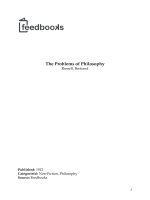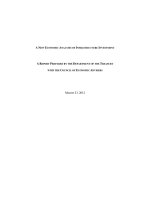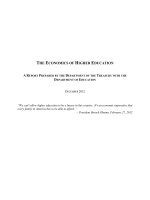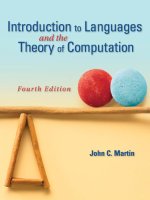Helping students to deal with the problems of learning new words
Bạn đang xem bản rút gọn của tài liệu. Xem và tải ngay bản đầy đủ của tài liệu tại đây (6.37 MB, 30 trang )
PART ONE: INTRODUCTION
I. SOME BRIEF INTRODUCTION OF ENGLISH.
In present time, English is an important and globle language. It is the key to
inergrate into the world. English has become an essential tool not only bring success
in business, industry, economy, transport, politics, science, culture, and education, but
also in life. Moreover, it is the only language to help people to travel all over the
world. Hence, without English, we are like the blind who can not see the world.
In recent years, English has become a compulsory subject in secondary
education programme and it is one of three main subjects in GCSE examinations.It is
a basic subject deciding that you are qualified enough or not to graduate from
universities. A big question raised to every English is “How to improve
students’English skills and to help them learn it effectively?”.Understanding the
importance of English and having been an English teacher for 10 years, especially
teaching in moutainous areas in Trieu Son, I am always finding the best way to give
my students a hand in studying this subsect. Today, I am so excited about presenting
my own long time experiences in teaching English to you so that it may assist you
something in your present career and lovely students.
II. THE REASONS FOR CHOOSING TOPIC.
As you know, there are four skills when learning English: reading, speaking,
listening and writing . In order to study one of them more effectively, students must
have a good knowledge of vocabularies. Because the vocabularies decide what you
speak, how you write,what you listen to and what you understand in the passage.But
until now, no theory has shown exactly that what you should do to learn words
best.Someone says that they learn by heart all the words the teacher gives, some other
people say that they learn word by doing exercises everyday, or the others say that
they learn words by reading books, newspapers, stories in English, watching TV,
listening to music in English and so on…All of them are correct but what they said is
not enough. And I think that everyone has their own way of studying English,
especially vocabularies. After along time of looking for and doing research, I have
made decision to change the methods helping my students to focus on studying new
1
words and chosen the topic "Helping students to deal with the problems of
learning new words" in my experience initiative to help them reinforce and practice
English exercises effectively and achieve good results in the exams.
PART TWO: CONTENT
Traditionally, teachers still have the habit of teaching vocabularies that they
always follow books, teachers are the centre of the lesson. Therefore, changing the
teaching methods makes almost teachers amused. Teaching vocabularies in new
method effectively needs the following steps:
I. PREPARATION
I.1. Teachers
- They need to spend much time looking for documents, pictures related to the
topic and they also continue to update information to support the lecture.
- They should make simply visual things very often to stimulate students during
their lessons.
- They should prepare their lessons carefully and in detail before going to
school.
I.2. Students
- They should collect documents, pictures related to the teacher’s lesson.
- They should prepare their lessons carefully and in detail before going to
school.
- Theyshould find and look up new words before gong to school..
- They should practise pronouncing English everyday.
- They should pay attention to what the teacher gives during the lessons, anwser
her questions actively, take part in working in pairs or in groups voluntarily.
II. WARMING UP
Depending on each lesson, the teaher must considerate how to start the lesson
so suitablly and attractivellythat the students feel like the lesson from the beginning.
2
Teachers need to lead their students to concentrate on the lesson in different
ways. For example, giving suggestions with some simple questions related to the
topic requiring students to brain storm and answering them personally. From that
base, the teacher introduce the lesson to students .
Giving active and creative rights to students: In the past, teachers were the
centre of the lesson but now students are the peoples doing much more than teacher so
as to form many confident skills of communication for studentds and use their source
of new words more often.Therefore, teacher must discove activities and games in
groups or in pairs so that students can make the lesson better. Basing on the demand
of each skill, teacher can use suitable techniques for every lesson. Teacher should
operate activities well and let students do with them flexibly but not rigidlyin any
forms.
III. SOME PRINCIPLES OF TEACHING NEW WORDS
In each lesson, teachers should find out from five to eight newwords to teach
but not all, and these words have to belong to be active vocabularies which mean that
they are used veryoften during the lesson in order to practise simple skills, especially
to practise speaking and writing skills..
Teachers should not let students repeat these words many times because
technical word repeatation will not bring good effects in understading the words but
this may make the lesson become boring and waste students’time and effort. As well
as teacchers.
Teachers should not write the pronunciation of the words in English on the
black board as students’ Vietnamese understanding is still limited but should
concentrate on learning the words inVietnames and English systems. If teachers give
students the signals of pronunciation, they will misunderstand between the writing
and pronunciation of a word.
IV. STEPS FOR PRESENTING NEW VOCABULARY
1-Use a suitable technique to elecit or show the meaning of the new vocabulary.
2-Model the pronunciation clearly ( 3 times )
3
3-Ask students to repeat the word chorrally and individually.
4-Correct students’ s pronunciation
5-Write the words on the board and students’ s copy down on their notebooks.
6-Check that students clearly understanding the meaning and pronunciation.
7-Draw students’ attentionto aspect of vocabulary such as part of speech,
callocation, frequency etc…..
8-Give students a written record.
(May be teacher ckecks that students write well in their vocabulary notebooks )
V. ELECITING TECHNIQUES FOR TEACHING VOCABULARY
True- False statements
Visuals
Realia
Mine
8 techniques
Synonym/
Antonym
Situation/Explain
ation
Example
Translation
4
V.1. Visuals
- Use a picture
- Draw on black
ex: The one pillar pagoda
worker /
mechanic
taxi driver
doctor
teacher
architecture
singer
5
peasant
actor
Picture of Ha Long Bay
V.2. Mine
- Facial expression
- Guesture
- Body action
ex: to brush ( one’ teeth )
6
Teacher takes a toothbrush then brushes her teeth
Tasks: “ what am I doing ?”
Ss: You are brushing your teeth
T: now repeat “ brush” ( 3 times )
7
V.3. Realia
- Use real things
(teacher brings
clock, chair, telephone, an apple, flowers………. Into the
class).
8
V.4. Situation/Antonym
- Use the questions
Ex: What’ s another word for “ holiday”?
Holiday= Vacation
What’ sthe opposite of “ happy”?
Happy # Sad
V.5. Translation
Teacher: How do you say “§iÓm ®Õn” in English?
Ex: A destination
V.6. True or False statements
Teacher gives some statements and asks students to choose the best answer.
Ex:A carpenter
T. says:
a- Carpenter takes care of a forest
b- Carpenter often works with wood.
c- Carpenter uses many tools
V.7. Example
ex1: rice, meat ,and fish are food (unc)
ex2: bananas, apples oranges …are fruits
ex3:shirts, trousers, jeans, shorts, dresses are clothes.
9
Ex4: beds, tables chairs are furniture furniture (unc)
10
11
Besides, teacheers can teach many words together to save time if they are
in the same group or they are synomym.
Ex: To teach “ smile” teachers should draw smiling symble and say:
T: Look at the picture . he is smiling . Now look at me .I’m smiling, too . “
Smile” is a verb . You smile when you happy . Repeat “ smile smile smile”
Ss: smile
T: Good. What does it mean in Vietnamese ?
Ss: mØm cêi
T: Well done
V.7. Recording vocabulary
- Using symbols
12
1- You can see the following symbols with synonyms, antonyms, traslations
and pictures
= is the same as
ex: good = nice
# is the same opposite
ex: good # bad
2- You can use the following symbols to show the stress or the link of sounds.
For the stressed syllable
For linking final consonants with vowels
Ex: an orange.
3- You can see the following words or abbreviationsfor the part of sentence .
- To
- a/an
– for verbs
ex: to visit
_for countable noun
ex: a destination
- (unc) _ for uncountable noun
ex: rice ( unc )
- (adj ) _ for adjectives
ex: excited (adj )
- ( adv) _ for adverbs
ex: quickly(adv)
4- you can use the following symbols for translative verbs; someone
for “someone” or him/her …ect
ex: (to) ask
5-You can simple underline prepositions or gerunds.
Ex: (to ) stay (with / for / in )
13
PART THREE: CHECKING TECHNIQUES FOR VOCABULARY
Rub out and
Remember
Jumbled words
Bingo
Ordering
7 techniques
Slapon the board
Matching
Slapon the board
I. RUB OUT AND REMEMBER
1-Teacher presents or elicits the vocabulary and builds up the list on the
blackboard.
2- After each word teacher puts the Vietnamese translation .
3- Teacher asks the students to copy into their books and then close their
books .
4- Teacher rubs out the new word one at a time.
5-Eacher time teacher rub out a word in English, point to the Vietnamese
translation and aks What is this in Vietnamese?
6- When all the Engkish words are rubbed out teacher go through the
Vietnamese list and get the studends to call out the English words
14
7- If there is time, teacher get the students to come to the black board and write
the English words again
*Note: it helps leaners to memories new vocabulary.
Ex: English 10-Unit 6 - Lesson 1
1.....:Kỳ nghỉ
5- ...: điểm đến
2- . ...: thành nội, thành cổ
6-...: thăm
3-...: vịnh
7-... : bãi biển
4.....: ở ( cùng với)
II. SLAP THE BOARD
1-Teacher puts the new words in English on the balck board in bubbles not in a
list.
2- If you want to check the understanding, put the Vieetnamese translationof
the new words or picture on the blakboard .
3-teacher divides the class in to two teamsof five or six to front of the class.
4-Teacher choose a student from each team and they stand at equal distance
from the blackboard.
5-Teacher calls out one of the new word in a low voice in Vietnamese.
6- Two students must runs forward and slap a word the word in English on the
board.
7- The one who slaps the correct word first is the winner.If students are playing
in teams ,the win team gets a mark.
8- Then teacher ask two more studentsto come forward ..etc.
* Note: There are two points to remember inS the B.If you use only English,
leaners are only recognizing the word in through listening.However if you use
Vietnamese translation or picture you can checkthe meaning of the new vocabulary.
Ex: English 11 - Unit 4 - Reading
Checking vocabulary: slap the board
15
donation
minority
benifit
gratitude
mow
remote
III. WHAT AND WHERE
1- Teacher writes the new words in the cicles on the black board not in a list.
2- When all the words are on the board, teacher ask the students to repeat the
words in cicles.
3- Teacher rubbed out one of the words but doesn’t rub out th cicles.
4-Teacher gets the students to repeat the words including the rubbed out words
by poiting at the empty cicles.
5- Teacher rubs out another word but leaves the cicles.
6- Teacher pointthe woed or empty cicles, students read and have to remember
all the words.
7-Continues till the cycles are empty.
8-Techer aks the students ( 6 or 8 at the time 0 to come to bb and fill in the
cicles with the correct words
Ex: English 11 –Unit 11- Lesson 1
release
consumption
renewable
infinite
alternative
16
exhausted
potential
* Note: This check technique is good for leaners to memorise the newwords
and also good for revision of vocabulary
IV. MATCHING
1- T. writes the newwords in the list on the left hand side of the bb.
2- T. writes the definitions, translation or draws pictures on the right hand side
of the bb.
3- T. asks the Ss to come to the bbto match the items on the left with those on
the right by drawing a line between them.
Ex1:English 7 –Unit 11-Lesson 5-Period 72
1-common cold
a-triệu trứng
2-disease
b-chảy nước mũi
3-symptom
c-bệnh cảm thường
4-runny nose
d-ho
5-slight fever
e-bệnh tật
6-cough
f- hắt xì hơi
7sneeze
g-sốt nhẹ
*Keys:
1-c;2-e;3-a;4-b;5-g;6-d;7-f
Ex2:
A bicyle
A star
An aeroplane
A pair of scissors
A cat
A bird
17
V. JUMBLED WORDS
1-T. sticks 6 flash cards with jumbled words on the board
tnotancc
prenstreteivea
cereseru
ralnatu
ropttce
cyrecle
2-T.asks Ss to rewrite the words in the right order
3-T tells Ssthe first two groups with the right word will get two points
4-T. corrects them.
5-T. asks Ss to read again
Ex: Unit 10 –English 10 - Period 61
*- Answer keys:
1- contact
3-resource
5- protect
2-representation
4- natural
6-recycle
*-Note:This cheking technique helps Ss remembering deeply the words they’ve
leant.
* Bingo:
1-T.draws box on bb and asks Ss to copy
2-T. Asks Ss to rewrite 6 new words they’ve learntin the box.
18
Ex:
A packet
A destination
A bay
Medicine
flu
A doctor
3- T. tells Ss that she/ he will say some words (8-10-12-15)
4- If Ss hear the word, they cross it out .Like this:
A bay
5-When Ss croos out all six words, shout “ bingo”. Who say “bingo”first will
be the winner.
* Note: This activities can be used to check and revise the newwords you have
introduced during the week
* Ordering:
1-T. writes the vocabulary on the board randomly.
2-T. have Ss to copy the words in to their exercise books.
3- T. read the phragraph aloud.
Ex: English 8 –Unit 12 –period 77
“Mrs Quyen & her husband visited many places in hthe USA while they
were .First, they went swimming at Waikiki Beach situated on the Hawaiian Island
of Oahu. There they could see the lava pouring out of the Kilawea Volcano when
they flew over head .They also saw the the head of 4 American President carved in
to the rock of the Mount Rushmore.
4-T. asks Ss to compare their answer withtheir partner.
6-T. asks Ss to give the anwers and read the text again to correct .
*Answer keys:
Volcano
(6)
went swimming(1)
19
Overhead
(7)
Isaland
pouring out (5)
(3)
Lava
carved
(4)
situated
(8)
(2)
PART FOUR: EXERCISES OF USING WORDS
After ter understanding the meaning of the words, teacher may ask students to
do some exercises to help them understand more about the usage of the words
through some activities in the class.
These exercises are often combined with the practice of using skills such as
listening, speaking. There are some following suggestion exercises:
1-TPR:Total Physiccal Response. Teacher gives some orders and asks students
to act.
Ex:T says “stand up”
Ss: Thùc hiÖn hµnh ®éng ®øng lªn
T: “sit down”
Ss: Thùc hiÖn hµnh ®éng ngåi xuèng
T: “clap your hands”
Ss: Thùc hiÖn hµnh ®éng vç tay
2- Group the words according to their topics)
tea
cofee
pork fish
rice
apple
chicken
beer
wine
tomato
meat lettuce
beef milk
FOOD
nuts
lemonade
butter
wheat
DRINKS
FRUIT
cabage
beans
VEGETABLES
……………………………………………………………………………………
…………………………………………………………………………………………
…………………………………………………………………………………………
……………………………………………………………………..................................
.........................................
20
3- Cicle the word which doesn’t belong to the group:
ex:scientist chemist
physican
mathematics
history
literature
English
school
walk
read
watch
TV
4-Fill in the empty cicle:
rice
bread
milk
fish
water
eggs
chicken
beef
lettuce
pork
tea
tomato
a-Work in pair to talk about your favorite food and drinks
Ilike………………..
I don’t like……………………
Drink
s
food
b- Intervew your partner about his /her favorite food and drinks then write the
report .
21
What do you like to eat ?
What do youlike to drink?
He/She likes…………….
He/She doesn’t like……..
c- Complete the sentnce to write about your daily meals:
I usually have…….. meals a day.I have………..at …………….o ‘clock .I like
………for breakfast but I don’t like…………because it’s …………..For lunch ,I
usually have……..and…...Ilike to drink ………….because it’s ……….I often
have………….for dinner.
5-Macth the verbs in column A with the appropriate words / phrases in column
B:
A
B
March
a drunk
Stroll
an elderly couple
Stagger
a sodier
a- Matching pairs
-Mini dailogues:
In this exercise, students have to do 2 sentences fo the conversation by
matching the questions with the anwsers or a sentence in card group A with a suitable
sentence in card group B .
+ The way to do:
- Cut the cards of group A and the cards of group B, mix them, then devide
them into equal parts and give them to each group with 4,5,6,7,8 .
-Each group is given one card group A and one card group B to join into 2
sentences of the conversation.
- Teacher limits time and stops students if time is over.
22
- Teacher goes pass every desk to check. Each group reads their own two
sentences. If they are right, they can leave the games and given one mark. However, if
they are wrong, they will not be given any marks. Teacher shoul not give the answers
and continues to check the rests.This exercise keeps on until the coubles of sentences
are suitable
Ex Card group A
1-How old are you?
2-Do you mind if I smoke?
3- I hope England wind the World Cup.
4-Help yourself to a drink
5- Would you help me with this, please?
6- I can’t come tonight. I’m afraid.
7-Today’s the 4th, isn’t it?
8- Could you give me lift home, tonight?
9-Is it far to the station?
10- I’m sorry, I’m late
Card group B
a- No, of course not
b-No, not very
c- Very well thank you
d- What’s a pity
e- Yes ,that’s right
f-You are wellcome
g-Thanks, the same to you
h-Yes, I’d be glad to
i-Yes, certainly
23
j-It’s a pleasure.I’m glad you like it
b- Crossword
This is the games almost students like.
ex:Hafl a crossword: Jobs and accupations
In this answer sheet, each box contains a word of career or job.
The way to do:
- Devide the class in to equal small groups A and B with 2 or 4 students.they
are sitting opposite . teacher gives group A some cards in which there are the
description of a job or a career. Teacher limits time . At this time teacher can explain
some students’ uncertainties.
-Group A and B take turn to ask and answer the questions and fil l in the
box.Ex: “What’s the third cross down?”, “what’s tenth cross?........Each group should
supply easy and simple questions or explainations so that the other one can find the
answer correctly and quickly.
-Teacher must limit the totall time of the games and stop both two groups when
time is.
-Two groups will compare the results and decide who is the winner.
Ex: These are the words that group A will have to explain to group B.
badminton
table tennis
gardening
swimming
camping
football
boxing
dressmaking
yoga
24
golf
PART FIVE: THE RESULTOF USING THE EXPERIENCE
Through manyteaching school years, with my new teaching method in the
lessons, I realise that my students can understand, pronounce, use new words easily.
They are very excited and active during the lessons.Theycan guess many new words
only by the pictures, situations and topics. Some students who were shy and closedminded in the past or inconfident in front of the class are very good at communicating
with their partners.I have created real situations for them so that they are able to
remember a lot of words deeply, especially difficult ones for them to guess.
With many skills of practising new worddsin the class and writing them at
home every day, my students can speak and write English words correctly. Therefore,
their English level is improved much better now.
Students’ results in the school year 2017-2018:
Kú I
Kú II
Khèi
SÜ sè
Giái
Kh¸
TB
YÕu
KÐm
10
80
15,5%
35,5%
30%
15%
4%
11
120
0%
40%
30%
20%
10%
10
80
18%
38%
35%
7%
2%
11
120
0%
50%
40%
5%
5%
Gifted students recognised by THANH HOA DEPARTMENT OF EDUCATION
AND TRAINING: 2
25









